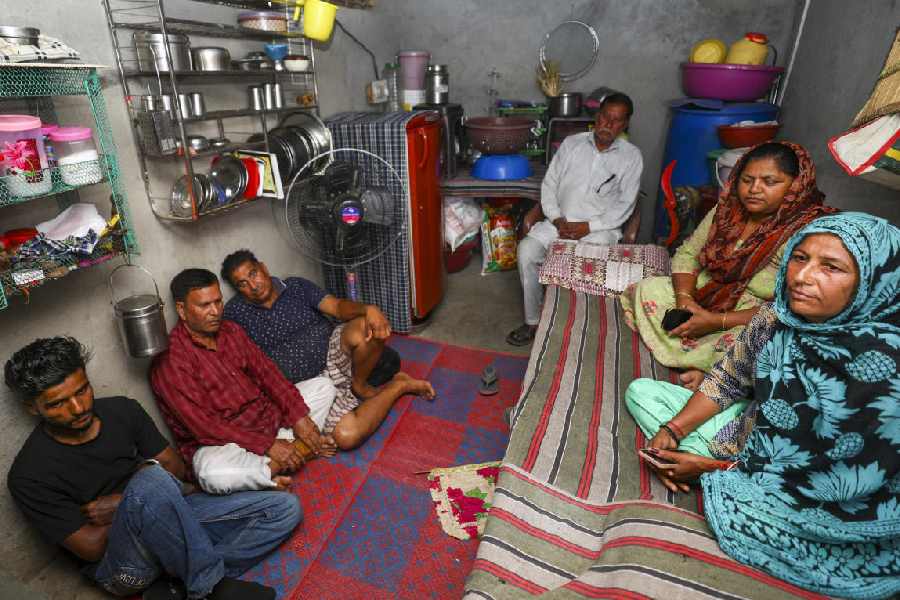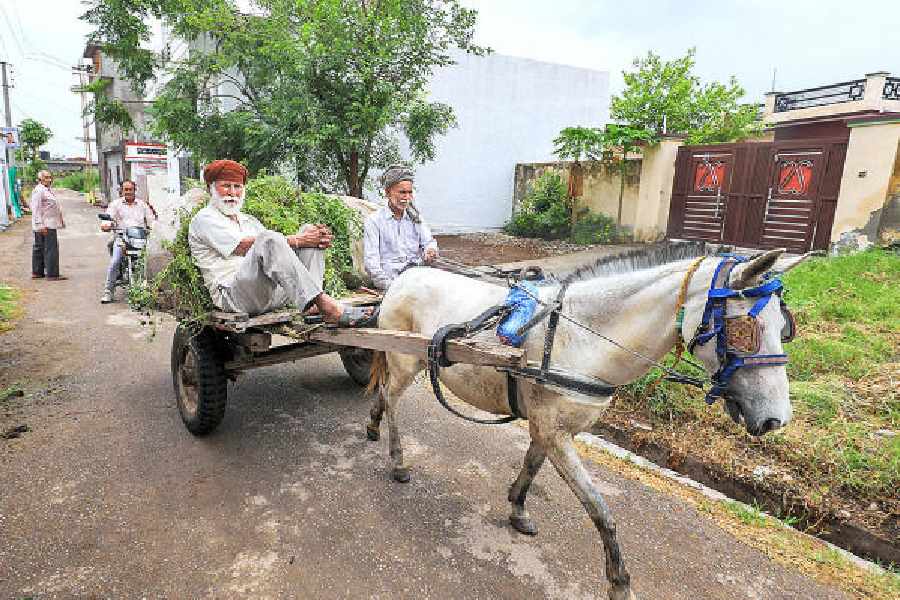 |
If you live in Bengal and eat rice, beware. Your wife unwittingly may be serving your family rice with small doses of arsenic — rice that’s grown with or cooked in contaminated groundwater.
Indeed, life-threatening arsenic could be making its way into hundreds and thousands of kitchens across the Indo-Bangladesh border and in pockets of Asia. Fresh reports of arsenic’s gradual and menacing entry into the ‘grain that Asia sustains itself on’ are pouring in from across the Asian continent — the Lao People Democratic Republic, Cambodia, Myanmar, China, Nepal, Vietnam and Pakistan.
Co-author of a paper with colleagues M. K. Sengupta, M. A. Hossain, A. Mukherjee, S. Ahamed, B. Das, B. Nayak and A. Pal in Food and Chemical Toxicology, the scientist contends that the groundwater arsenic contamination in the Bengal delta represents the largest chemical poisoning in history. Over 500 million people are at risk in the region, spread over nearly 600,000 square kilometres.
To make a realistic estimate of how big the problem is, the team adopted a scientifically sound approach: it tried to identify the three most common methods of cooking rice in the delta, dotted with hundreds of villages. “About 90 per cent of the villagers still use the traditional method of washing rice till the washings become clear, then boiling it in excess water and finally discarding the remaining water by tilting the pan against the lid. This gets rid of about 60 per cent of the arsenic in rice,” Chakrabarti told KnowHow. However, other methods are in vogue too — rice washed and boiled till all the water is absorbed so that there is no water to discard; and unwashed rice cooked in just enough water to boil. The scientists found these a little worrisome as a significant amount of arsenic was still retained in the rice cooked by these methods.
Explains Chakrabarti,“ During cooking, two principal processes take place: arsenic lacing of rice from contaminated water and arsenic removal through washing and by discarding the water. When the amount of intake exceeds the released amount, the total arsenic content in cooked rice is more than that in raw rice. This happens in the more contemporary process of cooking unwashed rice in just enough water to boil.”
When the arsenic concentration in raw rice is 10 micrograms per litre (the World Health Organisation’s recommended permissible level), the concentration of the toxic element in cooked rice is of low risk. But when the arsenic concentration in raw rice is 50 microgram per litre (the WHO permissible standard for developing countries), the scientists observed an average increase of 35-40 per cent in arsenic in cooked rice. This, Chakrabarti points out, is disconcerting.
Also of concern is the ‘rice cooker’ variety of cooking, where rice — washed or unwashed — is steamed in water retaining all arsenic within. Or the method prevalent in the West — rice steamed inside readymade water-proof packets. Rice from the eastern Indian delta travels across the country and finds it way into global markets.
First results
In the first experimental evidence of the strong link between arsenic and cooking methods, Chakrabarti’s team revealed that good old grandma’s method is still the best bet as far as getting rid of toxics like arsenic is concerned. “In fact, when we presented our findings at an international conference in the first week of September at Minamata in Japan, all Japanese scientists present there were unanimous that they should seriously rethink the electric cooking method prevalent in their country. Most still remember their grandmothers cooking rice the traditional Indian way and feel the country should possibly revert to that.”
Out of 12 rice varieties collected from arsenic-affected fields in West Bengal, eight were ‘boro’ (summer) crops. In the arsenic-affected areas, contaminated groundwater is used for irrigation during the boro season. The mean arsenic concentration of the eight boro rice varieties was 54 microgram/kg. The washing-discarding method was found to remove 57 per cent of arsenic from raw rice; the figure for the only washing method — 28 per cent. An adult male consumed about 136.25 and 228.17 microgram a day of arsenic, respectively, with rice cooked using these two methods. Those who cooked rice without washing or discarding water, took into their systems 316.91 microgram/day of arsenic, hugely exceeding the WHO permissible limits.
Andrew Meharg, a biogeochemist at the University of Aberdeen in the UK, showed in a global survey of grains recently that rice grown in the United States contains an average of 1.4 to 5 times more arsenic than rice from Europe, India or Bangladesh. People eating 500 grams of dry American rice a day were probably consuming more than the maximum intake of arsenic recommended by the WHO.
Meharg tested rice bought from markets in Aberdeen that had been grown in America, Europe, India, and Bangladesh. He found an average of 0.26 micrograms of arsenic in each gram of US rice. Indian rice hit a low of 0.05 micrograms per gram, whereas Bangladesh (which has had recurring problems with arsenic contamination owing to naturally high levels of the poison in groundwater) and Europe had about 0.15 micrograms per gram.
However, there was just one saving grace for American rice. It was found to have less arsenite and arsenate (the toxic components of arsenic) and more methyl arsonic acid and dimethyl arsenic acid (the relatively harmless components). On the other hand, Indian rice has its own flip side, says Chakrabarti. “It is grown on soil rich in arsenites and arsenates”.
Whatever be the permutations, Meharg himself has decided to stop eating American grains. “Low doses of arsenic such as these do not cause acute illness. It’s more about long-term intake that can elevate levels of cancer,” says Meharg. Research in Taiwan has linked arsenic-contaminated rice to an increase in bladder cancer.
Toxin trouble
 |
| Cook well : Young scientists from Jadavpur University with a rice cooker that promises to remove arsenic strains from rice |
In India, the prevalence of arsenic in groundwater has been established in pockets of West Bengal, Uttar Pradesh, Bihar, Jharkhand, Assam and all the seven north-eastern hill states. The condition in Manipur, being studied in depth, is serious, Chakrabarti says. Slow deposition of arsenic is known to cause cancers of the skin, lungs, kidney and bladder and can also lead to gangrene.
Chakrabarti and his team had found in an alarming study sometime back that a small 200 square feet plot of land in Deganga area of North 24 Parganas district saw an annual deposition of over 6.4 tonnes of arsenic. “This was just a small study and, surprisingly, we found that arsenic was making its way into the food chain through vegetables, rice and wheat.”
Meharg’s survey team found that contamination was a legacy of cotton farming, which relied on arsenic-based chemicals to kill boll weevils and to remove leaves before harvest. Quite a lot of the land in Mississippi and Arkansas that previously grew cotton is now used for rice cultivation.
When rice was first grown in these soils, the crop often failed owing to an arsenic-induced disease known as straighthead. So new, straighthead-resistant rice varieties were bred that could withstand the arsenic.
However, this means that they are more likely to accumulate arsenic in apparently healthy grains, says Meharg, who is now calling for a change in farming methods. “I don’t think they should be growing rice on old cotton fields,” he says.
Of the rice eaten in the United States, the vast majority is home grown. About half of all US-grown rice is exported.
But scientists are not yet ringing the alarm bells, contending that in the absence of any epidemiological evidence on the effects of a high rice diet, like the ones in Asia, nothing can be conclusively established. “I don’t see any serious concerns. But since increasing arsenic concentrations in the soil is a big issue, we are sceptical,” Chakrabarti says. “Flouride is a big menace with more than 62 million people suffering from fluorosis. Newer toxic compounds like magnesium, boron and the blindness-causing thallium are popping up every day. Who knows what’s next?”
Meharg found that just 42 per cent of arsenic in US rice was inorganic, meaning it contained the relatively less harmful non-carbon components methyl arsonic acid and dimethyl arsenic acid. Compared to that 81 per cent of arsenic in Indian rice was inorganic. But he argues that organic arsenic can still cause problems, and could convert into the inorganic and more toxic carbon bearing arsenates and arsenites in the body. While this eminent biogeochemist is advocating improved farming practices, Chakrabarti, says greater emphasis must be laid on the water used for irrigation. “We have to stop using groundwater. Rainwater could be the next best alternative.”










